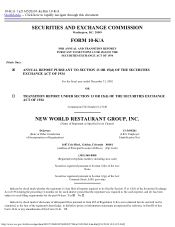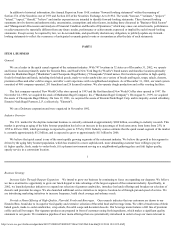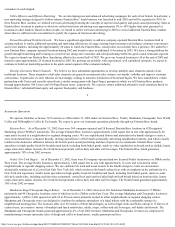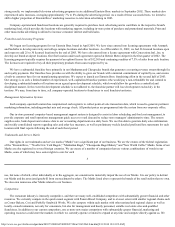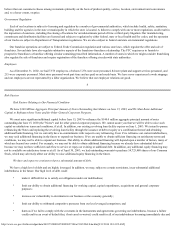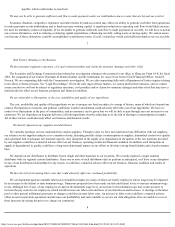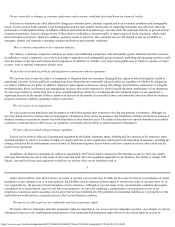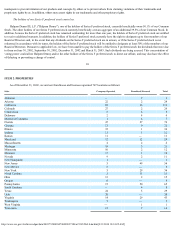Einstein Bros 2002 Annual Report Download - page 3
Download and view the complete annual report
Please find page 3 of the 2002 Einstein Bros annual report below. You can navigate through the pages in the report by either clicking on the pages listed below, or by using the keyword search tool below to find specific information within the annual report.
http://www.sec.gov/Archives/edgar/data/949373/000104746903027186/a2116520z10-ka.htm[9/11/2014 10:14:22 AM]
In addition to historical information, this Annual Report on Form 10-K contains "forward-looking statements" within the meaning of
Section 27A of the Securities Act of 1933 and Section 21E of the Securities Exchange Act of 1934. The words "forecast," "estimate," "project,"
"intend," "expect," "should," "believe" and similar expressions are intended to identify forward-looking statements. These forward-looking
statements involve known and unknown risks, uncertainties, assumptions and other factors, including those discussed in "Business-Risk Factors"
and "Management's Discussion and Analysis of Financial Condition and Results of Operations," which may cause our actual results, performance
or achievements to be materially different from any future results, performance or achievements expressed or implied by such forward-looking
statements. Except as may be required by law, we do not undertake, and specifically disclaim any obligation, to publicly update any forward-
looking statements to reflect the occurrence of anticipated or unanticipated events or circumstances after the date of such statements.
PART I
ITEM 1. BUSINESS
General
We are a leader in the quick casual segment of the restaurant industry. With 747 locations in 32 states as of December 31, 2002, we operate
and license locations primarily under the Einstein Bros. and Noah's New York Bagels ("Noah's") brand names and franchise locations primarily
under the Manhattan Bagel ("Manhattan") and Chesapeake Bagel Bakery ("Chesapeake") brand names. Our locations specialize in high-quality
foods for breakfast and lunch, including fresh baked goods, made-to-order sandwiches on a variety of breads and bagels, soups, salads, desserts,
premium coffees and other café beverages, and offer a café experience with a neighborhood emphasis. As of December 31, 2002, our retail system
consisted of 460 company-operated, 261 franchised and 26 licensed locations. We also operate dough production and coffee roasting facilities.
The first company-operated New World Coffee store opened in 1993 and the first franchised New World Coffee store opened in 1997. On
November 24, 1998, we acquired the stock of Manhattan Bagel Company, Inc. ("Manhattan Bagel Company"). On August 31, 1999, we acquired
the assets of Chesapeake Bagel Bakery. On June 19, 2001, we acquired the assets of Einstein/Noah Bagel Corp. and its majority-owned subsidiary,
Einstein Noah Bagel Partners, L.P. (collectively, "Einstein").
We are a Delaware corporation and were organized in November 1992.
Industry Overview
The U.S. market for the daytime restaurant business is currently estimated at approximately $200 billion, according to industry research. This
market is growing as aging of the baby boomer population has led to an increase in the percentage of food eaten away from home from 25% in
1955 to 46% in 2002, which percentage is expected to grow to 53% by 2010. Industry sources estimate that the quick casual segment of the market
is currently approximately $5.2 billion, and is expected to grow to approximately $11 billion by 2006.
We believe that quick casual is one of the most rapidly growing segments of the restaurant industry. We believe the growth in this segment is
driven by the aging baby boomer population, which has resulted in a more sophisticated, more demanding customer base willing to pay for
(i) higher quality, fresh, made-to-order foods, (ii) a pleasant environment serving as a neighborhood gathering place and (iii) higher quality,
speedy service in a convenient location.
1
Business Strategy
Increase Sales Through Daypart Expansion. We intend to grow our business by continuing to focus on expanding our dayparts. We believe
we have an attractive opportunity to grow our lunch daypart to take advantage of the largest segment of the restaurant industry. Specifically, in
2002, we launched product initiatives to expand our selection of gourmet sandwiches, introduce hot lunch offerings and broaden our selection of
desserts and premium beverages. We also launched additional service initiatives to improve location-level through-put and speed of service. We
are introducing marketing initiatives to increase frequency, build check average and enhance reach.
Provide a Menu Offering of High-Quality, Flavorful Foods and Beverages. Our research indicates that our customers are drawn to our
Einstein Bros. brand due to its superior food quality and extensive selection of flavorful food and beverage items. We offer a broad menu of fresh
baked goods, made-to-order sandwiches, crisp salads, flavorful soups and decadent desserts. Our beverage menu features a full line of premium
coffee and café beverages. Our signature products are prepared in front of customers using fresh ingredients, which makes a significant quality
statement to our guests. We maintain a pipeline of new menu offerings that are systematically introduced in order to keep our menu relevant to

